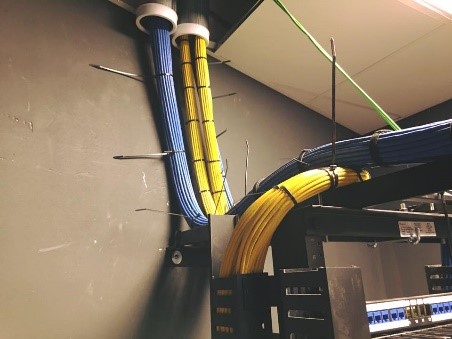Structured Cabling is an organized simple cabling system. It refers to the critical management of complicated and specific wiring that supports transmission of data, voice, video, and various management systems for security access and even power.
Unlike a standard point-to-point wiring system, Structured Cabling plays a vital role in communication infrastructure and can carry significantly increasing data at high rates.
Structured Cabling system enable the connection from hardware ports to patch panels at the top of a rack. The patch panel is connected through a trunk in the main distribution area, which serves as a place to accommodate all moves, adds and changes that can be made with patch cords.

This flexible setup saves significant installation and maintenance time, reduces the risk of human error when managing multiple, unorganized wiring, and minimizes network disruptions and downtime.
Within a Structured Cabling system there are a number of subsystems:
Entrance Facilities contain cables, network demarcation point(s), connecting hardware, protection devices, and other equipment that connect on-premise cabling.
Equipment Rooms serve as a centralized space for telecommunications equipment and main cross-connect or wiring consolation points. It is typically more complex than the Telecommunications Room or Enclosure, which houses the terminations of horizontal and backbone cabling to connecting hardware, such as jumpers or patch cords. Typically, every building will have at least one telecommunications enclosure ranging in size based on the scale of service area.
The Horizontal Cabling extends between a work area’s telecommunications information outlet with the horizontal cross-connect in the telecommunications room. It also contains optional consolidation points, horizontal cable, mechanical terminations, patch cords or jumpers. This wiring runs above the ceiling or below the floor. Both Ethernet cable and fiber optic cable are usually used for horizontal cabling.
Backbone Cabling or vertical wiring provides interconnection between the entrance facilities, equipment rooms and telecommunications rooms and access provider. this type of cabling is done from floor to floor, connected by cables that are shorter than 30 meters, including fiber optic cable, coaxial cable, unshielded twisted-pair (UTP) cable, and shielded twisted-pair (STP) cable. Finally, the Work Area is a place for components used to connect end-user equipment to communications outlets and station equipment.
Overall, cabling infrastructure is complex. That’s why it is essential that you have someone on your team who understands all aspects of this highly technical area.
For people who finance, build and run commercial structures, Encompass AV is like an insurance policy for your IT and AV with reliable Structured Cabling. We design our AV/IT networks so that everyone can count on crisp video, clear audio and uninterrupted streams of critical data.
Our Structured Cabling backbones support faster WiFi, PoE lighting and next-gen systems so you can operate smarter — for reduced TCO— in the long term.